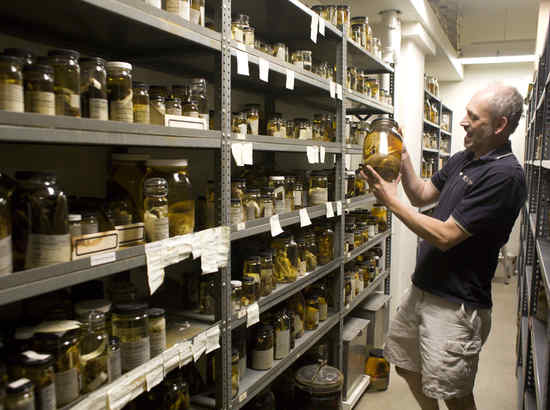New Bat Species Discovered In Museum Collection
Posted by: Loren Coleman on July 11th, 2009

Ed Hille/ Staff Photographer
In the Hollywood version, a biologist tramps about in the jungle, trapping exotic new species with a net. In the Philadelphia version, the biologist makes equally unprecedented finds by looking on the shelf. Ned Gilmore , collections manager for the department of vertebrate zoology, Academy of Natural Sciences, holds a jar containing the Norway Rats originally collected by a nephew of Napoleon. It is among jars like these at the Academy that Pteropus allenorum was found.
Reporter Tom Avril has written a wonderful article on Saturday, July 11, 2009, in the Philadelphia Inquirer, saying it all in the headline: “A new species found in a jar: Old bat resurfaces at Academy of Natural Sciences.”
Here are some highlights.
The furry, winged creature was shot down in the South Pacific and brought by ship to Philadelphia, where it was skinned and stored in a jar of alcohol alongside other curios of the Victorian era.
It was a kind of fruit bat, also called a flying fox for its foxlike face. Yet only now, after sitting on a shelf for more than 150 years, has it finally been “discovered” as a new species.
And it is probably extinct.
Scientists from the Smithsonian Institution came upon the unusual specimen during a 2006 visit to the Academy of Natural Sciences. After scouring the world’s museums to ensure that there was nothing else like it, they published their finding last month, and this week it gained wider notice with publication online.
***
Academy records show the bat was collected in 1856 by Henry Clay Caldwell of the Navy on the Samoan island of Upolu. It came into the possession of William S. W. Ruschenberger, a surgeon who at various times was president of the College of Physicians and of the academy. He donated it in 1857….
Because it is believed to be the only one of its kind, the new Philadelphia bat will now serve as a “type” specimen – the official scientific example of that species. Gilmore tied a red ribbon on the jar to indicate the bat’s new status….
The creature had a wingspan of at least two feet, and it weighed a half-pound when alive. In the paper, published in the journal American Museum Novitates, Helgen identified a second, even larger bat species in the collection of the Smithsonian.
Helgen, whose coauthors include his wife, Lauren, and Smithsonian bat specialist Don Wilson, dubbed the academy’s specimen Pteropus allenorum. They took the name in part from Allen Drew, an old friend who hosted them here.
It was originally labeled as a different species, but that was back when few bats had been collected, and scientists had too few samples to sort into distinct groups.
A similar tale is told in the academy’s current exhibit on geckos, where a placard describes how Aaron Bauer, a biologist at Villanova University, identified a new species in a French museum.
“We’re always reevaluating,” Bauer said. “As more material becomes available over time, it’s really necessary to go back again and again and again,” to reexamine existing finds.
And then there are the critters that have yet to be given any scientific name.
A few years ago, for example, a team of insect-hunters stopped by the academy and came up with eight new species of walking stick, said Jason Weintraub, manager of the museum’s entomology collection. Thousands more insects in that collection remain to be identified, he said.
“There are more discoveries to be made behind the scenes,” Helgen said. “I look forward to getting back to the academy and doing it more justice, and seeing what else unexpected is locked away in the cabinets.”
About Loren Coleman
Loren Coleman is one of the world’s leading cryptozoologists, some say “the” leading living cryptozoologist. Certainly, he is acknowledged as the current living American researcher and writer who has most popularized cryptozoology in the late 20th and early 21st centuries.
Starting his fieldwork and investigations in 1960, after traveling and trekking extensively in pursuit of cryptozoological mysteries, Coleman began writing to share his experiences in 1969. An honorary member of Ivan T. Sanderson’s Society for the Investigation of the Unexplained in the 1970s, Coleman has been bestowed with similar honorary memberships of the North Idaho College Cryptozoology Club in 1983, and in subsequent years, that of the British Columbia Scientific Cryptozoology Club, CryptoSafari International, and other international organizations. He was also a Life Member and Benefactor of the International Society of Cryptozoology (now-defunct).
Loren Coleman’s daily blog, as a member of the Cryptomundo Team, served as an ongoing avenue of communication for the ever-growing body of cryptozoo news from 2005 through 2013. He returned as an infrequent contributor beginning Halloween week of 2015.
Coleman is the founder in 2003, and current director of the International Cryptozoology Museum in Portland, Maine.










The article describing the new species is online.
Cool find, but it is sad that they believe it is extinct. We can only hope that the scientist are wrong on this verdict.